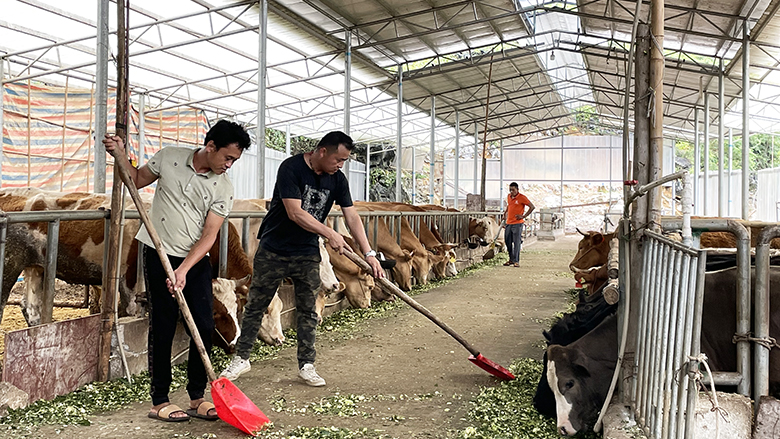In addition, the program has supported dragonhead (leading) enterprises and farmer cooperatives, professional farmers training and basic rural infrastructure in 28 poorer counties (with poverty rate above 11 percent or poverty headcounts above 60,000).
In the mountainous Tiandeng county, cropland is scarce. Although farmers are still able to grow some corn, it is not sufficient to support their lives. Raising cattle is providing many in the rural community with an additional livelihood and source of income.
The program has supported farmers’ cattle raising cooperatives along with linkages with businesses to facilitate integration of small farmers into the modern agricultural value chain and raise rural incomes.
Lu Yong’en is the head of the Pinli Longda Cattle Raising Cooperative which he founded in 2017, after he and his wife returned from Guangdong province where they had worked as migrant workers.
With help from the program, Lu’s cooperative has signed a cooperation agreement with Haoniuyuan Livestock Company to bring in high quality cattle breeds and reproductive technologies.
Farmers join the cooperative by contributing cash, land use rights or cows. “I contributed a cow. When my cow gives birth to a calf, the cooperative pays me 3,000 yuan (about US$463). In addition, I work on the cooperative’s cattle farm for 15 days each month and make 100 yuan (about US$15.4) a day,” Lu Yongxin said.
The Nanning-based Siye Livestock Company started its operation in Tiandeng in 2018. The company has received a loan from the program and set up a new cattle farm, a livestock market and a slaughterhouse with a processing plant in the county.
The company has developed contractual relationships with 11 farmer cooperatives to purchase forage crops, while providing support in terms of artificial breeding, veterinary services and new techniques such as silage fermentation. More than 3,000 farmer households have benefited from these arrangements.
Farmers can sell their cattle directly at the company’s livestock market, which cuts out the middleman and ensures the best sales prices. Those from nearby villages can find job opportunities at the company during the forage harvesting season. Farmers can also bring their livestock wastes to be converted into organic fertilizer, which reduces greenhouse gas emissions and environmental pollution.
Both Siye and Haoniuyuan, along with a few other companies that are working with farmer cooperatives have been officially accredited as poverty reduction dragonhead enterprises.
Individual livestock farmers are offered a 15-day professional farmers training course. Those who participated said they had learned new skills from the training, such as breed selection, feed preparation, vaccination, and animal disease prevention and control.
After training, farmers continue to gain practical knowledge and techniques through an app installed on their mobile phones. They can also seek advice directly from experts in a WeChat group formed during the training.
The mountain villages in Tiandeng ensured water shortages for years. Villagers had to capture rainwater from their rooftops and store it in water cisterns for drinking and other needs. Today this is no longer necessary, thanks to a program-financed new rural drinking water system that has brought safe water from the nearby township.
“We don’t rely on rainwater now. We have tap water and it is very convenient,” said Ruan Guibai, a resident in Pinli Village, proudly showing off her washing machine and flush toilet.
China announced the eradication of extreme poverty at the end of 2020. For counties lifted out of poverty, the central government has set a five-year transition period with major support policies unchanged. The institutional innovations introduced under the Guangxi Poverty Reduction PforR will continue to play their role in consolidating poverty reduction achievements, addressing remaining vulnerabilities, and implementing the rural revitalization strategy.
To truly meet the needs of the poor, a management information system on poverty reduction infrastructure projects has been created in the 106 counties tasked with poverty reduction across Guangxi. A bottom-up, participatory approach was adopted in identifying the projects starting with village consultation.
Villagers discussed what infrastructure they needed the most, for example, water, electricity or road. Project proposals were then submitted to the township- and county-level governments for review and approval, and the information in the project database was made available to the public in the entire process.
The information system has made project management easier and more efficient for government officials. “We can use it to monitor the implementation status of projects in townships and counties without actually going there,” said Li Jun, a deputy director of the regional poverty reduction office.
How are these projects financed? Integrating poverty reduction funds is key. With poverty reduction as a top priority, funds are allocated from many departments of the central and regional governments. Pooling these funds together to focus on the most urgent needs or priority projects can maximize efficiency and effectiveness of resources.
Described as “diverting water from multiple sources and drawing it off through a single tap”, Li Xia, a deputy director from the Guangxi finance department said, “this innovative financing mechanism has addressed the fragmentation problem in resource utilization, and enhanced the financial capability of the poor counties in poverty reduction.” Approval authority has been decentralized to let the counties decide how to spend the money.
The indicators designed by the World Bank operation are used to measure the performance of integrated poverty reduction funds. Prof. Liang Suping and her team from the Guangxi University of Finance and Economics have been commissioned for third-party performance monitoring and evaluation (M&E). She believes that the M&E system is an important contribution from the World Bank.
“It is a good tool to monitor the use of funds and assess value for money. It can also help governments at all levels to improve public management and reform government functions,” she said.

